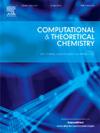基于机器学习的电子性质分析作为查尔酮衍生物抗胆碱酯酶活性的预测因子
IF 3
3区 化学
Q3 CHEMISTRY, PHYSICAL
引用次数: 0
摘要
在本研究中,我们研究了抗胆碱酯酶化合物的电子性质与其生物活性之间的关系。虽然在之前的研究中已经有效地探索了这种相关性,但我们采用了一种更先进的方法:机器学习。我们分析了一组22个具有相似查尔酮骨架的分子,根据它们的IC50指数将它们分为两组:高活性和低活性。使用开源软件Orca,我们计算了这些分子的几何形状和电子结构。超过100个参数被提取出来,包括Mulliken和Lowdin电子居群、分子轨道能量和Mayer的自由价,形成了机器学习特征的基础。通过我们的分析,我们开发了能够区分这两组人的模型。值得注意的是,信息量最大的描述符仅依赖于电子居群和轨道能量。通过计算确定生物活性的相关性质可以提高药物开发效率,节省时间和资源。本文章由计算机程序翻译,如有差异,请以英文原文为准。
Machine learning-based analysis of electronic properties as predictors of anticholinesterase activity in chalcone derivatives
In this study, we investigated the correlation between the electronic properties of anticholinesterase compounds and their biological activity. While this correlation has been effectively explored in previous studies, we employed a more advanced approach: machine learning. We analyzed a set of 22 molecules sharing a similar chalcone skeleton, categorizing them into two groups based on their IC50 indices: high and low activity. Using the open-source software Orca, we calculated the geometries and electronic structures of these molecules. Over a hundred parameters were extracted, including Mulliken and Lowdin electronic populations, molecular orbital energies, and Mayer’s free valences, forming the foundation for machine learning features. Through our analysis, we developed models capable of distinguishing between the two groups. Notably, the most informative descriptor relied solely on electronic populations and orbital energies. Identifying computationally relevant properties for biological activity enhances drug development efficiency, saving time and resources.
求助全文
通过发布文献求助,成功后即可免费获取论文全文。
去求助
来源期刊

Computational and Theoretical Chemistry
CHEMISTRY, PHYSICAL-
CiteScore
4.20
自引率
10.70%
发文量
331
审稿时长
31 days
期刊介绍:
Computational and Theoretical Chemistry publishes high quality, original reports of significance in computational and theoretical chemistry including those that deal with problems of structure, properties, energetics, weak interactions, reaction mechanisms, catalysis, and reaction rates involving atoms, molecules, clusters, surfaces, and bulk matter.
 求助内容:
求助内容: 应助结果提醒方式:
应助结果提醒方式:


